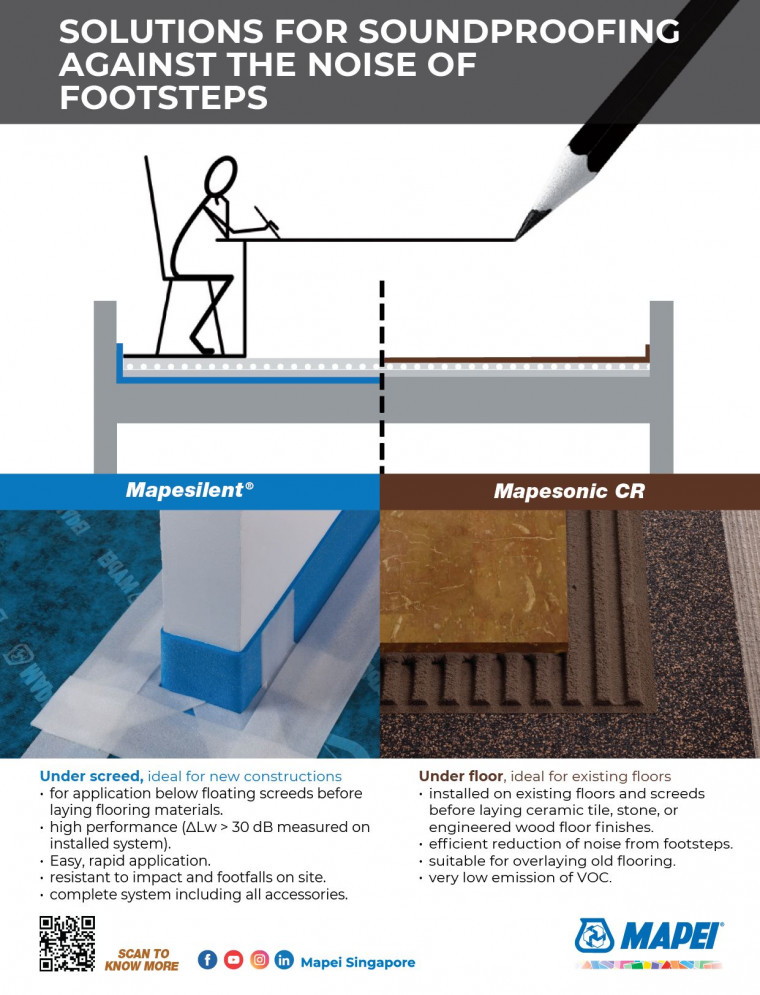The Anti-Noise Defence System for Commerical, Homes Soundproofing




Mapei Specific Products For Soundproofing.
Where does the noise in our homes come from?
The sounds we hear in buildings, which is then perceived as noise if it disturbs or irritates us, come from the street, from plant systems running through the building and from neighbouring apartments. From a technical point of view, acoustic pollution can be airborne, from plant systems or from the noise of footsteps. Each of these sources of noise corresponds to a specific construction technique.
What is impact noise or footstep noise?
These types of noise are usually generated by footsteps or by objects being dropped or dragged along the floor. Amongst the possible sources of disturbance, impact noise is the most common and the most irritating.
And what can we do to alleviate it?
In new builds, soundproofing material with the ability to dampen sound waves can be placed between the flooring and the load-bearing structure of the floor. The soundproofing system is placed underneath the screed so that you create a “floating screed” at least 4 cm thick. This solution is the most widely adopted because it is easy to install, pretty effective, quite cheap and it is easy to design using special acoustic prediction software.
In these types of cases, MAPESILENT by Mapei is the ideal solution for newly constructed buildings to achieve a level of soundproofing against footstep noise in line with the legal requirements set, for instance, by Italian Ministerial Decree 5-12-97, and that can reach the higher levels of acoustic efficiency (Class I and Class II) specified in the new Italian standard UNI 11367 regarding footstep noise.
And when carrying out renovation work?
In the case of renovation work on existing buildings too, where you do not intend (or it is simply not possible) to remove the old flooring and screed, Mapei proposes MAPESONIC CR, a compact (2 or 4 mm thick) soundproofing membrane that is placed directly over existing cementitious substatres or old flooring before installing new ceramic, stone, multi-layered wood or resilient flooring.
Can the type of final flooring help with soundproofing?
Absolutely. Surfaces covered with carpet, resilient material (such as rubber, PVC or linoleum) and wood have a positive effect on the reduction of footstep noise transmission. No type of flooring, however, is sufficient to comply with the legal limits or to have a significant effect on reducing the transmission of noise, unless it is combined with an adequate soundproofing system.

About Mapesilent Roll:
Sheets with a bitumen and special polymer-based elasto-plastomeric membrane with polyester reinforcement sandwiched to a layer of resilient polyester fibre coated with blue, non-woven polypropylene fabric with a 5 cm wide self-adhesive border along the sides.
Download the Technical Data Sheet here.
About Mapesonic CR:
Soundproofing mat in sheets of rubber and cork applied on substrates before installing ceramic, stone, resilient and multi-layered wooden floors.
Download the Technical Data Sheet here.
Click on the link below to find out more:




 Indonesia
Indonesia
 Australia
Australia
 New Zealand
New Zealand
 Philippines
Philippines
 Hongkong
Hongkong
 Malaysia
Malaysia







